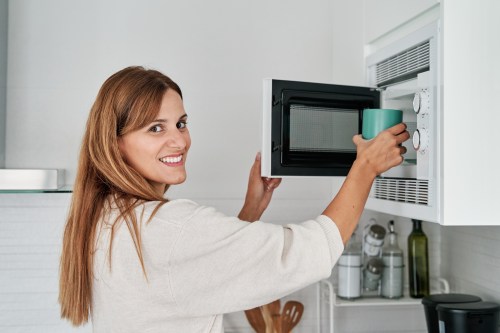Our editors independently select these products. Making a purchase through our links may earn Well+Good a commission
This Is Easiest Way To Check if Your Coffee Maker Desperately Needs To Be Cleaned
Here's how to clean a coffee maker—plus how often you should clean your coffee machine—according to a coffee expert and barista.

If you’re committed to forgoing a daily trip to the coffee shop in favor of brewing your own at home, you might be forgetting one important step in your coffee routine that could be impacting the flavor and strength of your morning brew: the part where you clean it, often referred to as ‘descaling.’
Experts in This Article
Whether you’re a home barista managing a fully-outfitted countertop espresso maker or simply plunging a French press (or Nespresso pod) daily, every coffee maker needs to be cleaned regularly to produce the best-tasting, freshest joe. If you’re wondering how often and how to clean a coffee maker, we have all the answers from coffee machine pros ahead.
Why is it important to clean your coffee machine?
With every appliance, from your dishwasher to your air fryer, a deep cleaning every now and then can improve the functioning and lifespan, and your coffee maker is no different.
“With regular surface-level cleaning, you can ensure that your machine functions well for a very long time—but a deeper clean is useful to take care of oil buildup in places that you don’t always hit with a regular clean,” says Pat Cotter, a coffee expert at Seattle Coffee Gear. This is especially important if you own a pricy machine. “With proper maintenance, many higher-end espresso machines can last a decade or more. It’s a bit like a car: Take care of it, and it’ll run for years and years.”
Every time you make a cup of coffee, water runs through the machine. Most tap water contains trace amounts of minerals like calcium, which can stick to the surface of the tubes inside the machine and build up over time. This slows down water flow and can impact the flavor and strength of your coffee.
“With proper maintenance, many higher-end espresso machines can last a decade or more. It’s a bit like a car: Take care of it, and it’ll run for years and years.”
How to know when it’s time to deep clean your coffee maker
What’s in your mug will often be the tell-tale sign that it’s time to scrub down the insides of your machine. “The first thing you’ll probably notice is the taste of the coffee will be stale or off,” says Cotter.
But the exact kind of buildup you’re dealing with can vary. For example, limescale buildup can make your coffee taste extra bitter. But other kinds of buildup, or worse, mold or mildew, can yield very unpleasant tasting (and smelling) joe. Your coffee might also have less color and body than it once did, and an electric machine may sound like it’s working extra hard to brew.
Mold or mildew can yield very unpleasant tasting (and smelling) joe. Your coffee might also have less color and body than it once did, and an electric machine may sound like it’s working extra hard to brew.
Ideally, however, you clean your machine regularly enough that it never reaches these extremes. The manufacturer’s manual often has guidelines for how often to clean it. For Nespresso, it’s every three months with regular use, or 300 capsules, according to Nespresso Machine specialist Brian Mulay.
How to clean a coffee maker—and what kind of machine is the easiest to clean
There are dozens of coffee makers out there, and they’re far from equal when it comes to maintenance. For example, Cotter notes that superautomatic machines, which dispense espresso at the touch of a button, like a Keurig or Nespresso, require less manual maintenance than fancier espresso makers. “These machines automatically flush and rinse after brewing, often feature built-in water filtration systems, and generally have programmed reminders to alert you of cleaning needs.” For the very best way to clean your specific machine, it’s best to consult the manufacturer’s manual or website.
The most basic coffee makers, such as French presses and pour-overs, can often be cleaned directly in the dishwasher or by hand. For drip coffee makers, it’s best to check the product manual first—but to descale without buying any expensive cleaning kits, experts say you can use dental tablets (weird flex, but it works) to cut through bacteria that could be lurking inside the machine’s water filtration system.
Cleaning a semi-automatic espresso machine
Semi-automatic brewers, such as espresso machines that you feed beans into for every cup, are more labor-intensive to maintain. “Most parts need to be cleaned manually, and consumables like gaskets need to be replaced over time. They also require the owner to keep track of cleaning cycles, so we often recommend a professional espresso machine cleaning service after a few years of use,” says Cotter.
On a very regular basis, it’s a good idea to empty and clean the drip tray and any removable parts and wipe down the exterior. If you have a semi-automatic machine, Cotter recommends removing the shower screen and gasket regularly to clean them and check for any damage that might warrant a replacement.
When it’s time for a deep clean, you can soak the removable parts (like a water tank, carafe, or drip tray) in a cleaning solution. Cotter recommends Cafiza, which is made specifically for coffee machines. “Descaling and changing the water filter should usually be performed once per year,” says Cotter. “It’s very important to follow your machine’s guidance for descaling. Many home machines should be taken to professional repair shops for descaling to avoid damaging the machine.”
How to clean a Nespresso machine
If like me, you love the convenience of a push-button coffee maker, you may have a Nespresso machine at home. The brand makes cleaning your coffee maker about as easy as brewing a cup.
Newer Nespresso machines, such as the all-new Vertuo Latissima, have an indicator light that lets you know it’s time for descaling, as well as an automatic rinse-through cycle that you can run every week.
You’ll need a descaling kit, which is a powder solution that goes into the water reservoir and runs through the machine to remove any build-up. “The descaling agent gently eliminates limescale to ensure that your tasting experience is as perfect as the first day,” says Mulay. “It’s also important to wash spare parts regularly with warm, mild soapy water (water tanks, drip trays, capsule bins, etc.).
Sign Up for Our Daily Newsletter
Get all the latest in wellness, trends, food, fitness, beauty, and more delivered right to your inbox.
Got it, you've been added to our email list.










